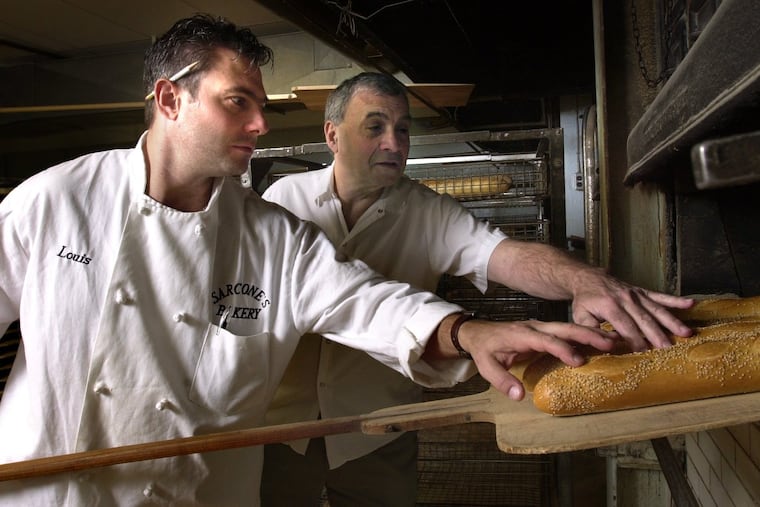The flavor also rises: Baking bread takes time at Sarcone’s
"I could double my business in a minute," boasts Louis Sr., Sarcone's father, now 66. "But I'd be the same as Amoroso. I want to be different."

This piece was originally published Dec. 9, 2001.
"Ninety percent of bakeries work the dough right out of the mixer," says Louis Sarcone Jr., 38, snappy in his baker's whites, his crew sliding long wooden paddles into – and then back out of – the tile-faced brick ovens. "We let it sit two hours before we touch it. "
He is trying to answer my question, which, simply put, is this: What's the flavor secret of the distinctive seeded breads and round rolls Sarcone's has sold since Grandfather Luigi started baking downstairs in 1918?
This is daily bread, artisanal only because it was never otherwise: $1.25 for a long sesame-seeded loaf (a nickel less for no seeds), the rolls priced just as amazingly: $2.50 for a dozen cushiony kaisers.
Sarcone sneers at gourmet stores selling bread for $3 "that's not half as good. " But he is proud, and he is proud to be stubborn. After an arsonist's firebomb – thought to be the work of a single firebug – scorched the front shop last fall, he reopened within weeks, selling loaves out of brown paper bags, and just two months ago unveiled an artfully retiled and remodeled retail space.
Still, he didn't raise prices.
Nowhere have I eaten such remarkable bread, delicately crisp in its eggshell-thin crust; light, moist and stretchy (but not squishy) in the crumb; a slight tang of salt giving it, for want of a better word, presence.
It is morning-warm bread, almost all of it for the walk-in trade. It doesn't circulate widely beyond its Ninth Street home.
Just 2,000 loaves a day come out of the cast-iron mouths of the ovens, some headed for South Philadelphia hoagie shops or, quirkily, the storefront Vietnamese hoagie places on Eighth Street that warm it until the crust magnificently crackles and then stuff it with cilantro, bright cucumber, meats and pate.
"I could double my business in a minute," boasts Louis Sr., Sarcone's father, now 66. "But I'd be the same as Amoroso. I want to be different. "
He cannot be different, he says, or true to his father's memory unless he lets the dough rest – it takes fully six hours (and three risings) from start to finished loaf. And unless he uses the same Pillsbury flour. ("I could buy cheaper flour, but I would never change the flour. ") And forgoes chemical shortcuts, employing only water, flour, salt and yeast to work their traditional magic.
Still, the biggest flavor secret, in his opinion, is the one industrial bakers have abandoned for speed and blandness: You need to bake the bread directly on the oven's firebrick floor to draw flavor out of the dough (not in metal trays in one of those newfangled revolving ovens).
Despite its pedigree, Sarcone's doesn't fit the typical profile of Italian bread. It doesn't possess that Tuscan density; or ciabatta's drier, bubbled texture; or the peasant chewiness of the loaves from Cacia's, a few blocks away.
In fact, but for its distinctly Italian dough, the styling – the look, texture, baking and shape – gives it a certain Frenchified aspect.
Once upon a time, Sarcone's sold another, denser, heavier round Sicilian bread, Louis Sr. tells me. But demand petered out as the old-timers died.
Little else has changed, thank goodness. Nor do the Sarcones – more than 80 years later – have illusions of empire or grandeur.
"My grandfather used to say," says Louis Jr., "'Put too much food in your mouth, you can't chew. '"
L. Sarcone & Son, 756 S. Ninth St., 215-922-0445